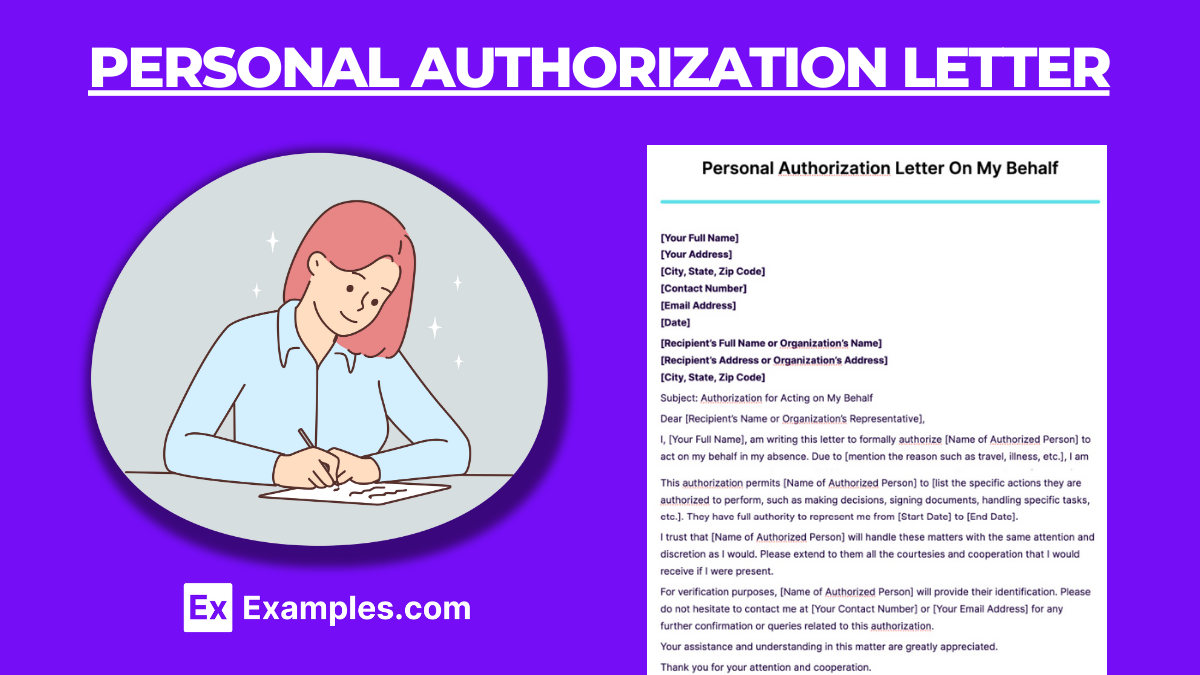40+ Personal Authorization Letter Examples to Download
Discover the essential components of crafting a personal authorization letter with our comprehensive guide, complete with practical examples. Whether you’re delegating responsibilities or authorizing someone to act on your behalf, our guide simplifies the process. We delve into various scenarios, offering tailored letter examples to suit your specific needs. Learn how to effectively communicate your intent and requirements in a clear, concise manner. Our letter examples serve as a perfect starting point for creating a legally sound and effective authorization document.
What is an Authorization Letter?
A personal authorization letter is a formal document that grants someone else the permission to act on your behalf in specific personal matters. It outlines the scope of the authorized actions, duration of authorization, and identifies both the person granting the permission and the authorized individual. This type of letter is used for various personal reasons, including financial transactions, collection of documents, medical decisions, and other personal affairs where representation is needed.
Key Elements of an Authorization Letter
An authorization letter is a formal document that allows one person to grant permission to another person to perform a specific task, access resources, or make decisions on their behalf. Writing an effective authorization letter involves several key elements to ensure its clarity, legality, and acceptance by third parties. Here are the essential components to include in an authorization letter:
- Date: The letter should start with the date when the authorization is given, to indicate its validity period.
- Sender’s Details: Include the name, address, and contact information of the person granting the authorization (referred to as the principal).
- Recipient’s Details: Mention the name, address, and contact information of the recipient of the letter (the person or entity being communicated to, such as a bank or institution).
- Agent’s Details: Clearly state the name and identifying details of the person who is being authorized (referred to as the agent).
- Authorization Statement: A clear and concise statement specifying what the agent is being authorized to do. This should include any relevant details such as account numbers, transaction types, or specific actions to be taken.
- Validity Period: Specify the duration of the authorization, including start and end dates, to define how long the authorization is effective.
- Purpose of the Authorization: Explain why the authorization is being given. This provides context and justifies the need for the authorization.
- Limitations or Conditions: If there are any restrictions or specific conditions under which the authorization is granted, they should be clearly mentioned to avoid misuse or overstepping of boundaries.
- Signature: The letter must be signed by the person granting the authorization to make it legally binding. If applicable, a witness or notary public can also sign the letter to add an extra layer of authenticity.
- Optional Elements:
- Witness or Notary Public Acknowledgment: In some cases, especially for significant financial transactions or legal matters, it might be necessary to have the letter witnessed or notarized.
- Attachments: If the authorization refers to specific documents (like a legal document, contract, or ID), attaching copies of these documents can provide further clarity and proof of intent.
- Closing Statement: A polite closing statement, followed by the sender’s name and signature.
Types of Personal Authorization Letter
- Financial Authorization Letter: This grants someone the authority to conduct financial transactions on your behalf, such as managing bank accounts, withdrawing money, making investments, or handling financial negotiations.
- Medical Authorization Letter: Allows an appointed person to make medical decisions or gain access to medical records on your behalf, often used in case of medical emergencies or incapacity.
- Child Care Authorization Letter: Grants a caregiver or relative the authority to make decisions regarding your child’s health and welfare in your absence, including medical treatments or educational matters.
- Power of Attorney (POA): A more formal document that grants broad or specific legal powers to another person, such as managing your finances, legal matters, or health care decisions, depending on the type of POA.
- Travel Authorization Letter for Minors: Allows a child to travel with an adult who is not their legal guardian, specifying the adult’s authority over the child during the trip. It’s often required for international travel.
- Vehicle Authorization Letter: Grants permission for someone else to use your vehicle, including for driving tests, registration purposes, or cross-border travel.
- Property Authorization Letter: Authorizes someone to manage or make decisions about your property, including selling, leasing, or maintaining it in your absence.
- Collection Authorization Letter: Allows someone to collect documents, packages, or other items on your behalf, often used for postal services or document retrieval from official institutions.
- Bank Authorization Letter: Specifically authorizes someone to perform banking transactions on your behalf, such as making withdrawals, deposits, or accessing safety deposit boxes.
- Letter of Consent for Passport Application: Gives permission for a passport to be issued for a child, often requiring the consent of both parents or legal guardians.
- Educational Authorization Letter: Grants permission for someone to make educational decisions, access records, or represent a student in school-related matters.
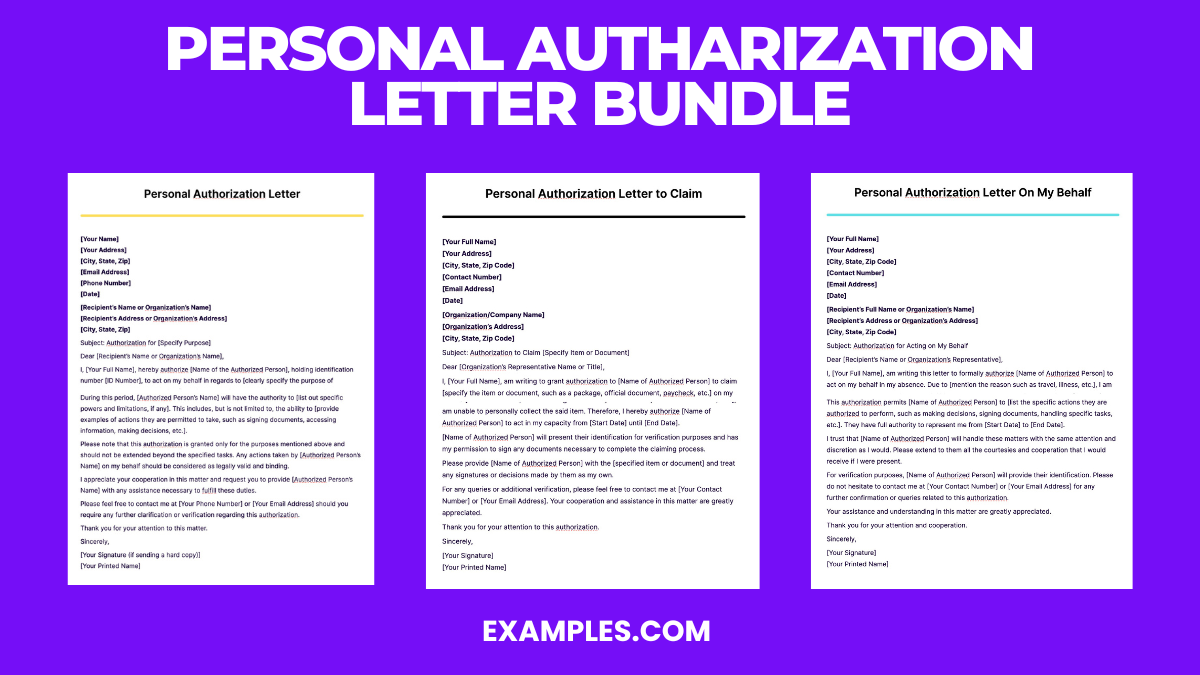
Download Personal Authorization Letter Bundle
Format of Personal Authorization Letter
A personal authorization letter allows someone else to act on your behalf in personal matters. Here’s a basic format to help you draft such a letter:
[Your Full Name]
[Your Address]
[City, State, Zip Code]
[Phone Number]
[Email Address]
[Date]
[Recipient’s Full Name or Organization’s Name]
[Recipient’s Address or Organization’s Address]
[City, State, Zip Code]
Dear [Recipient’s Name or Organization’s Name],
I, [Your Full Name], hereby authorize [Authorized Person’s Full Name], of [Authorized Person’s Address], to act on my behalf in dealing with matters related to [specify the matters, e.g., collecting documents, handling bank transactions, etc.], from [Start Date] until [End Date or “further notice”].
[Optional: Briefly explain the reason for this authorization.]
During this period, [Authorized Person’s Full Name] is granted the authority to [specify the actions they are allowed to perform, e.g., withdraw funds, sign documents, make decisions, etc.].
Please recognize the bearer of this letter, [Authorized Person’s Full Name], as my official representative and extend cooperation as needed.
This authorization is valid from [Start Date] to [End Date or “until revoked”]. I understand that I may revoke this authorization at any time by providing written notice.
Should you require any further confirmation or have any queries regarding this authorization, please feel free to contact me at [Your Phone Number] or [Your Email Address].
Thank you for your attention to this matter.
Sincerely,
[Your Signature]
[Your Printed Name]
Personal Authorization Letter For Different Purposes
Personal Authorization Letter
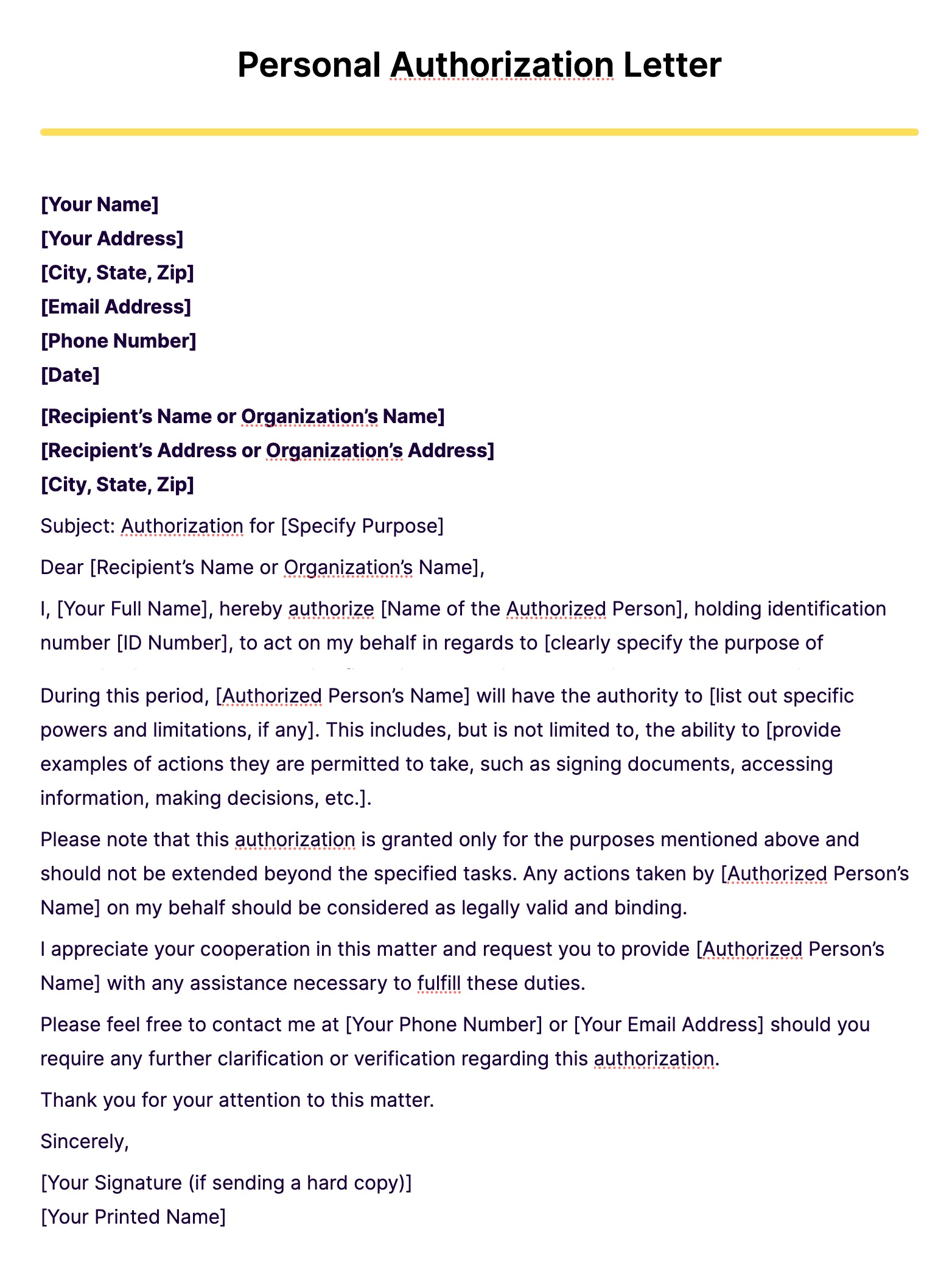
Personal Authorization Letter to Claim
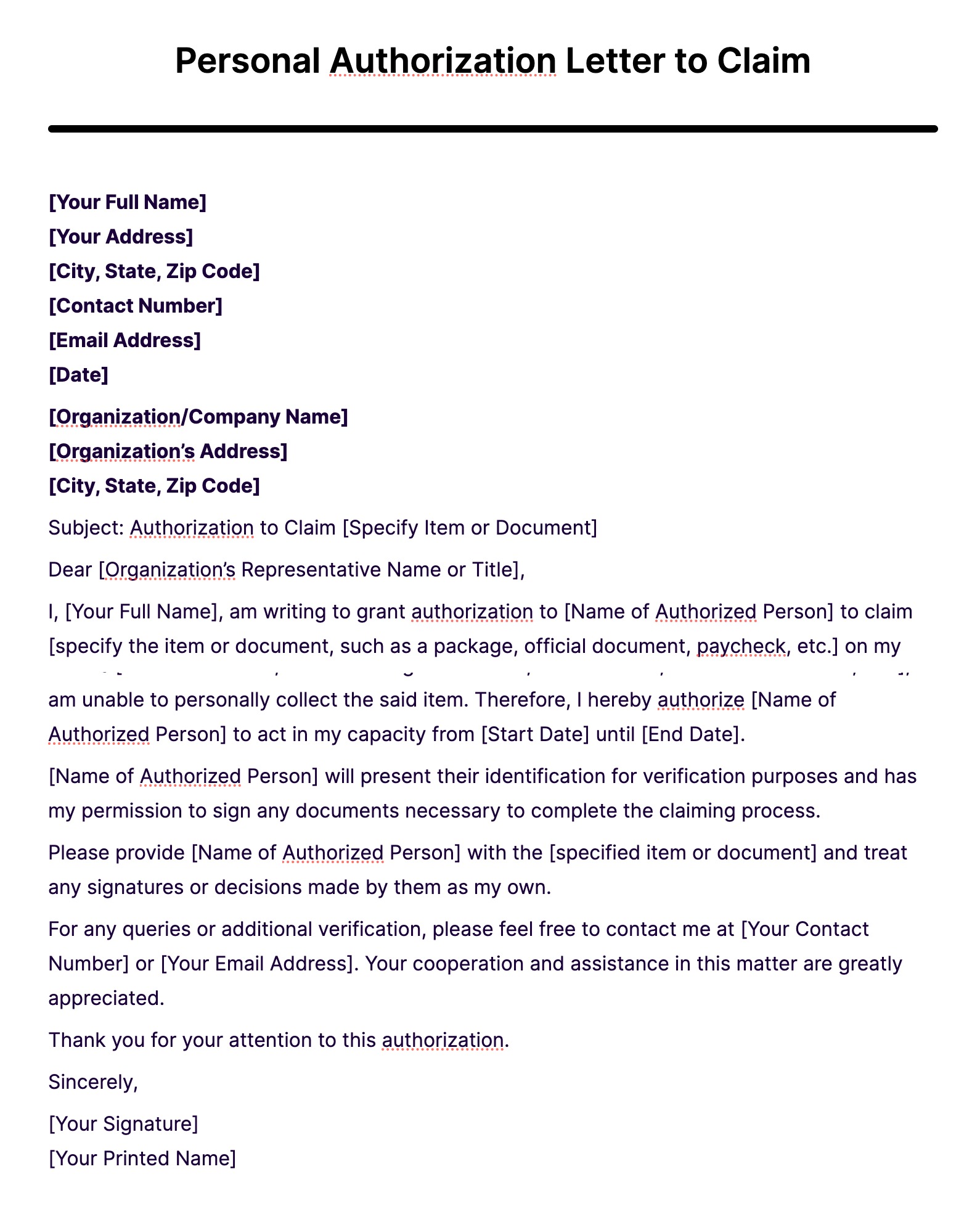
Personal Authorization Letter On My Behalf
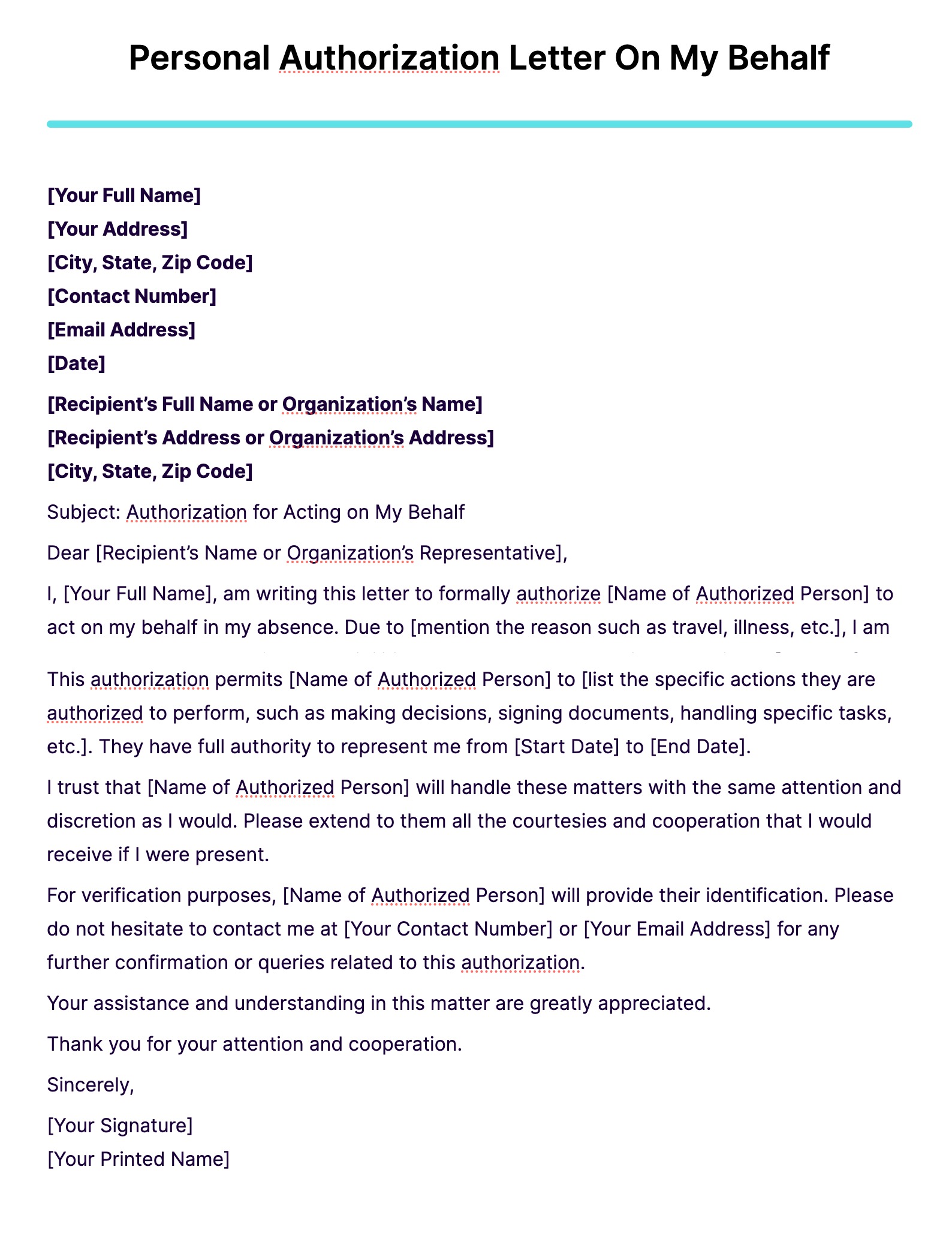
Sample Notarized Letter of Authorization Template
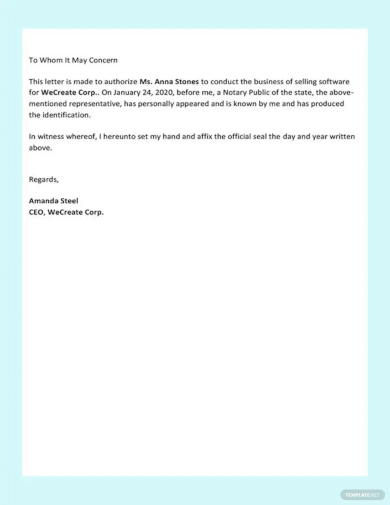
Authorization Letter to Transfer Money Template
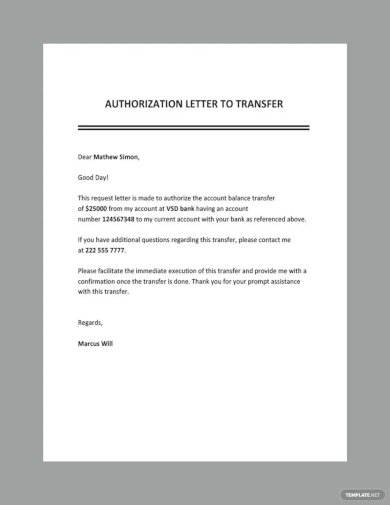
Free Return Authorization Letter Template
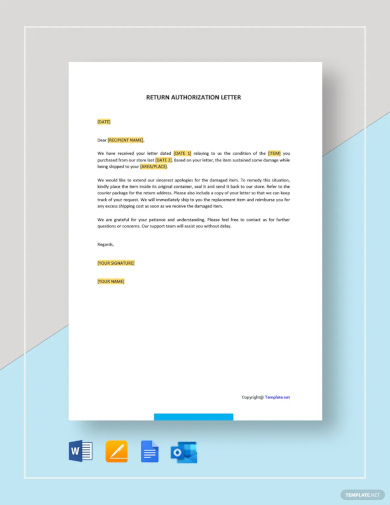
Work Authorization Letter Template

Authorization Letter Template To Sell Property
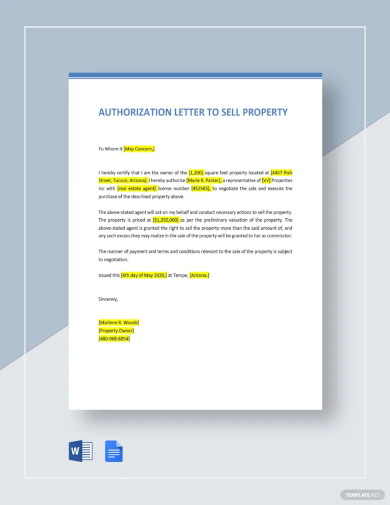
Letter of Authorization to Negotiate Template
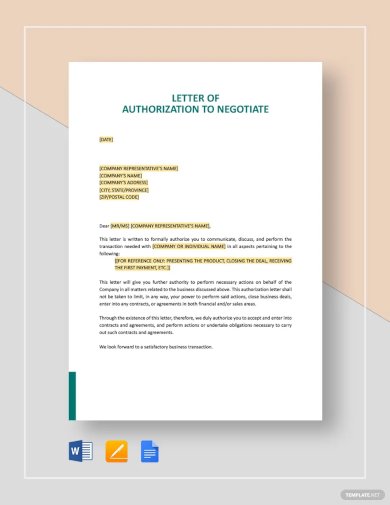
Free Authorization to Debit Account Template
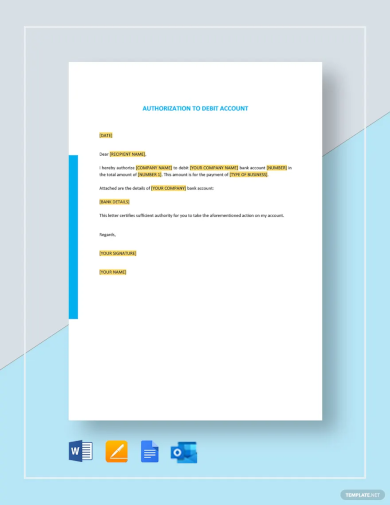
Free Request for Work Authorization Letter Template
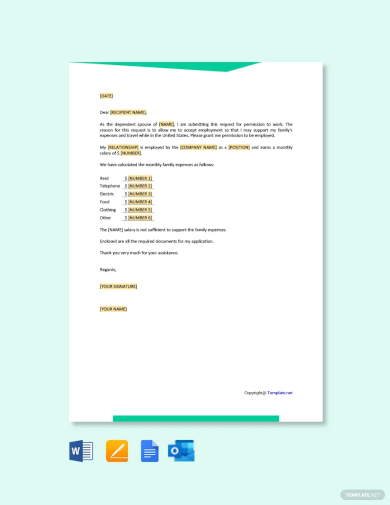
Notarized Personal Authorization Letter Example
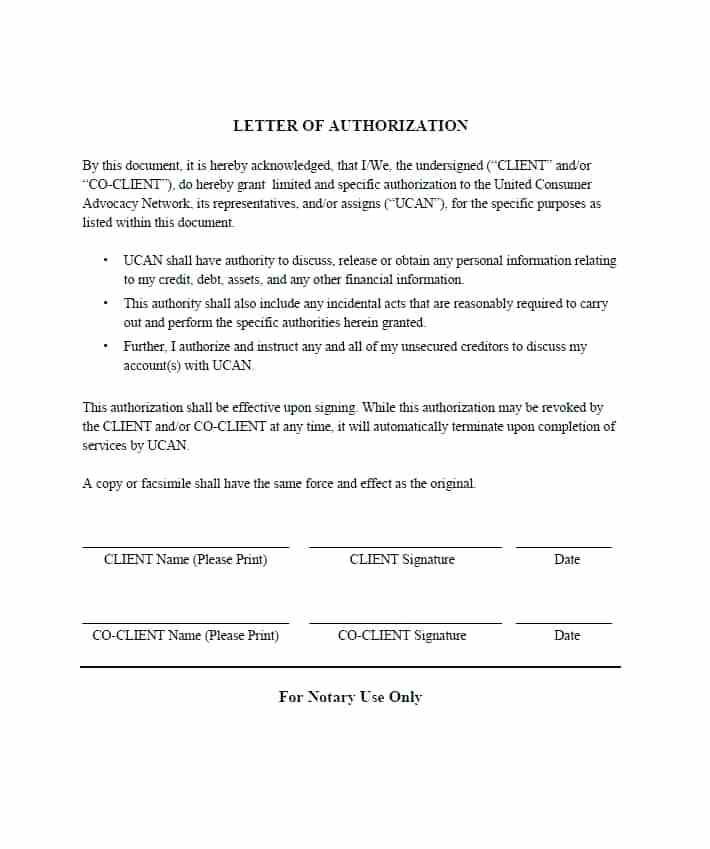
Personal Authorization Letter for Bank Example

Personal Authorization Letter for Child Example
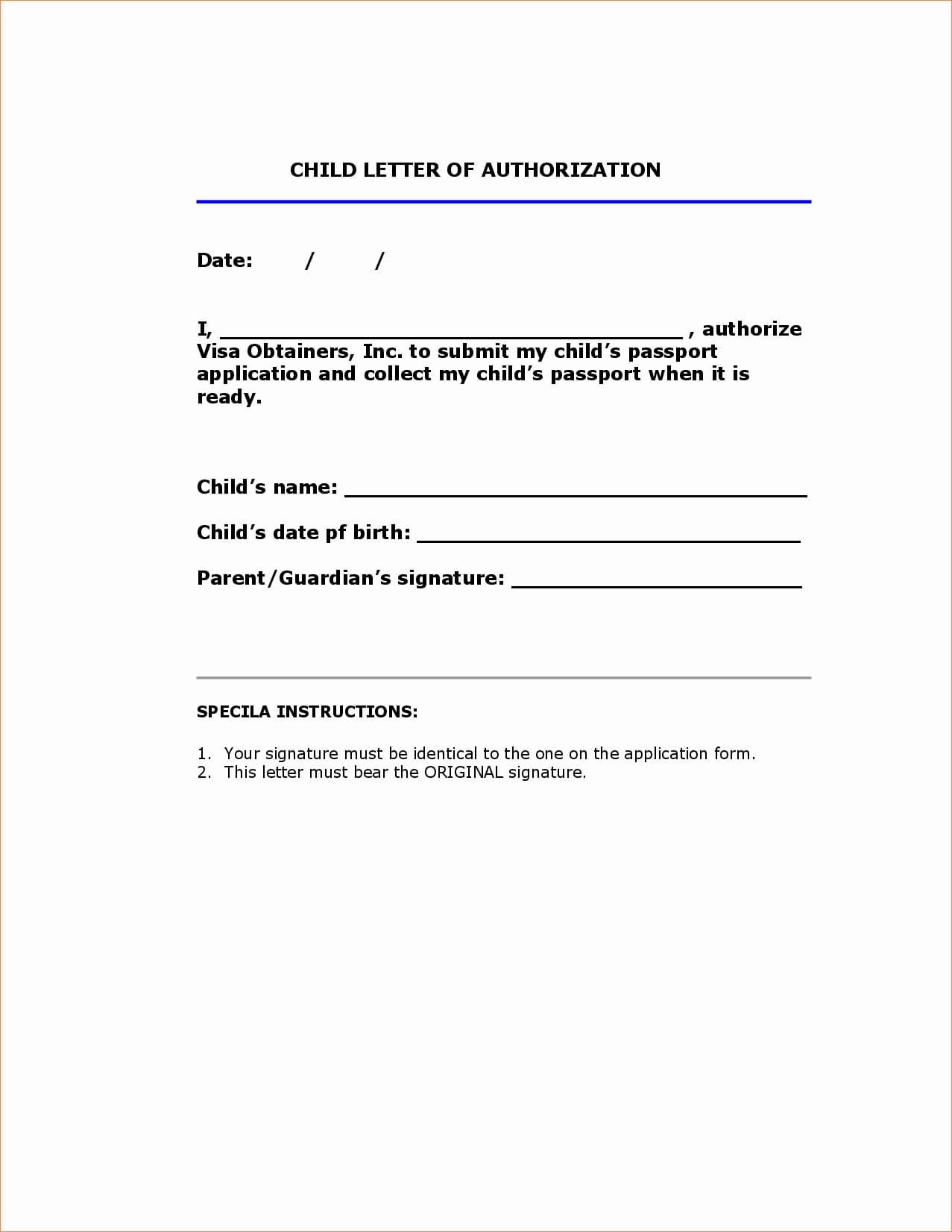
Personal Authorization Letter Format Example
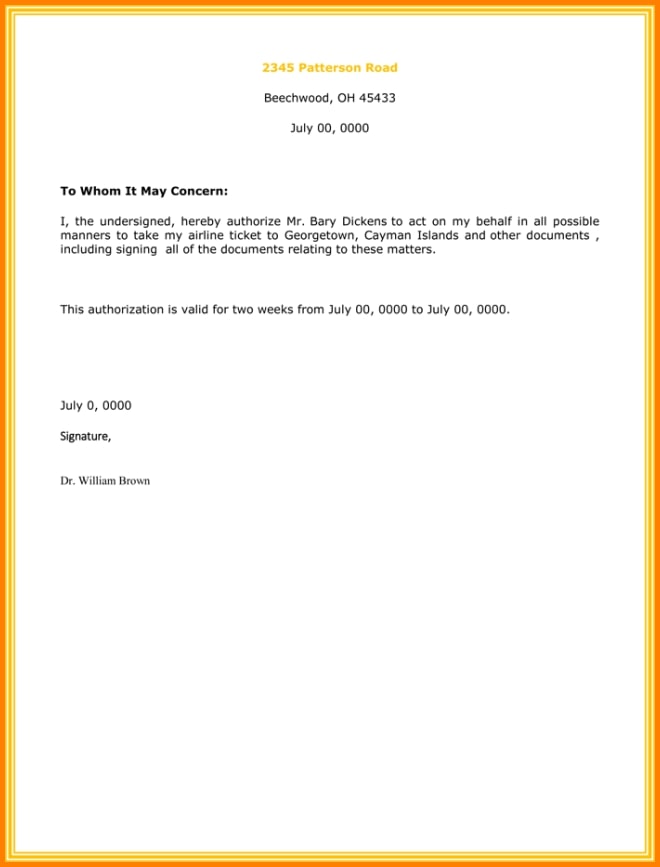
Personal Authorization Letter Form Example

Personal Authorization Letter for Visa Example
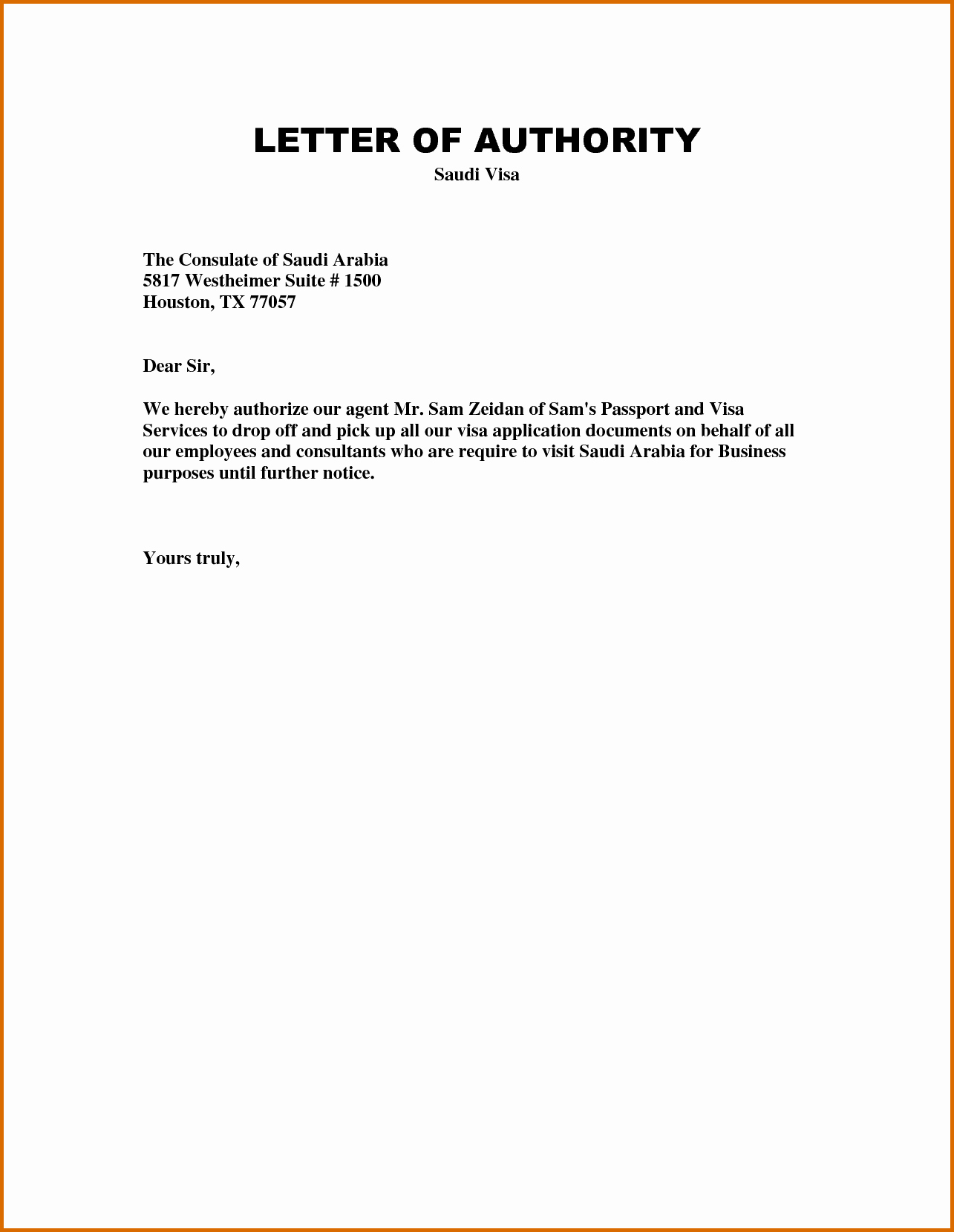
Personal Authorization Letter Sample
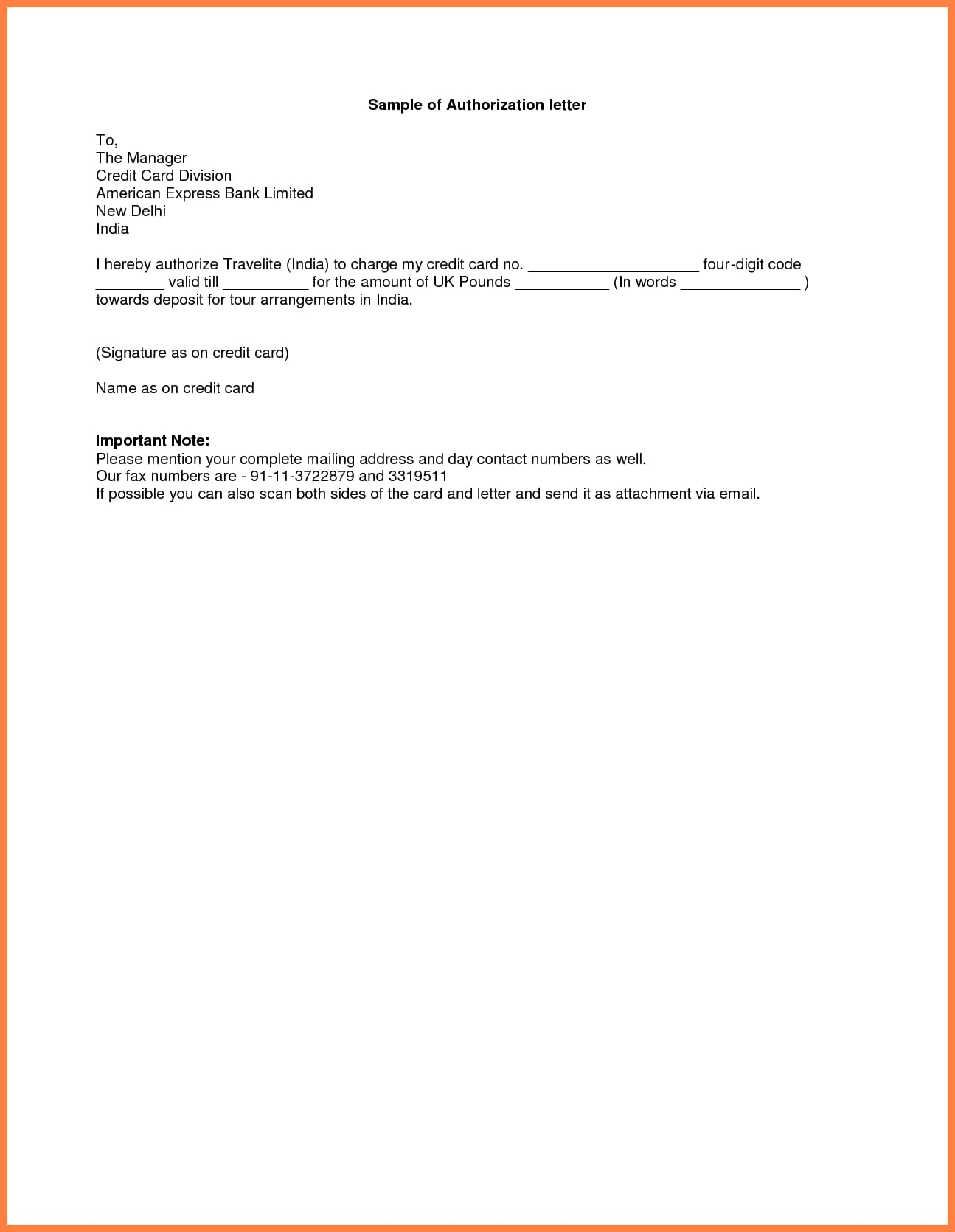
Personal Authorization Letter to Act Example
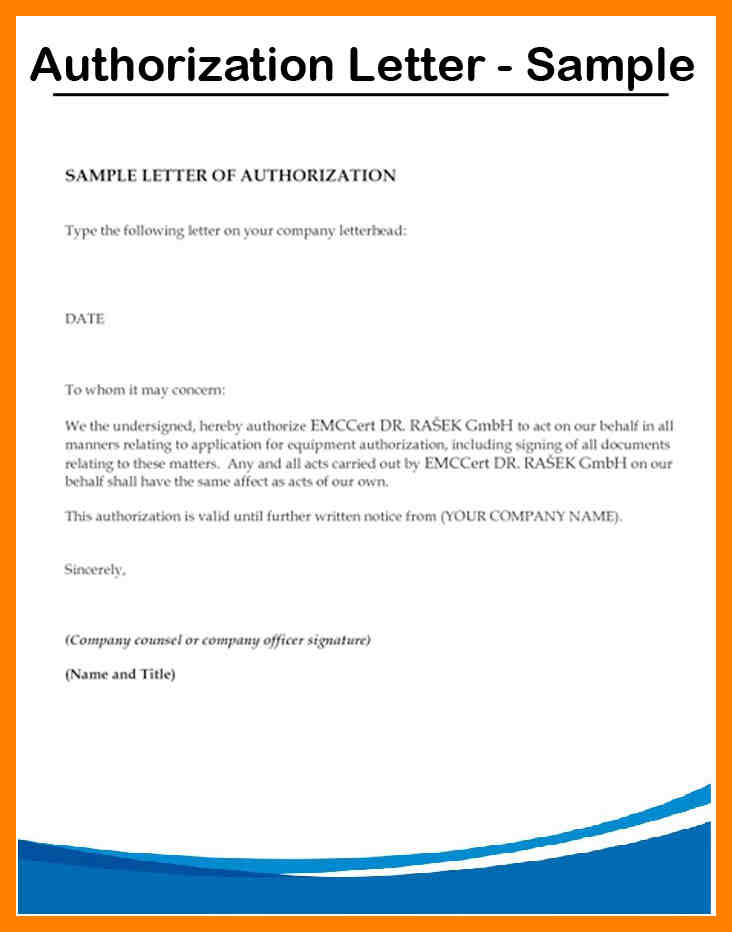
Personal Authorization Letter to Claim Documents Example
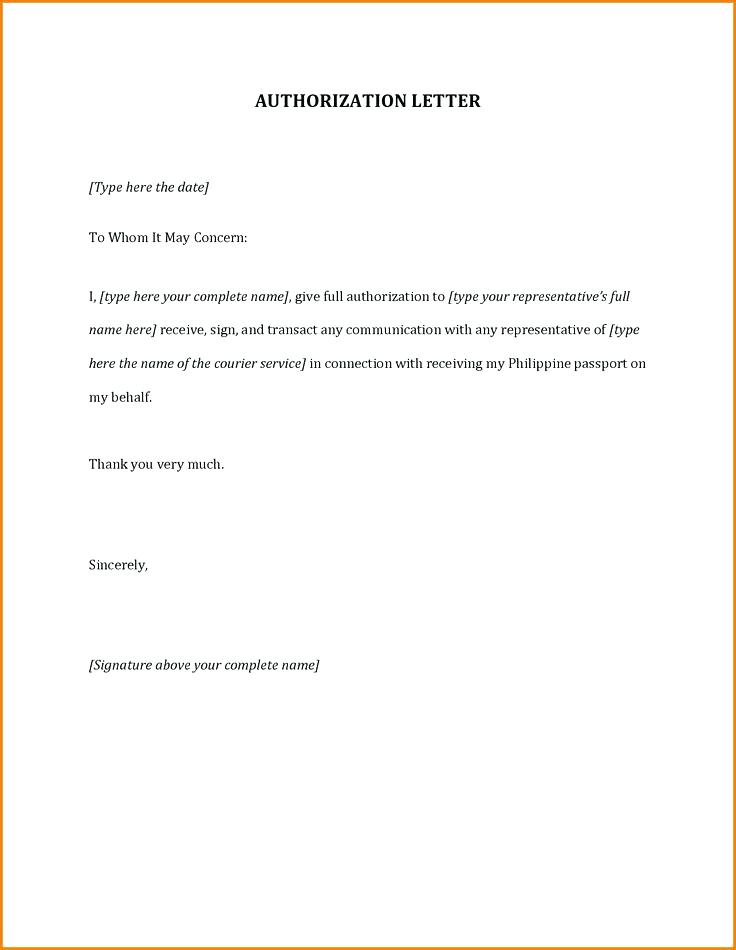
Short Personal Authorization Letter Example
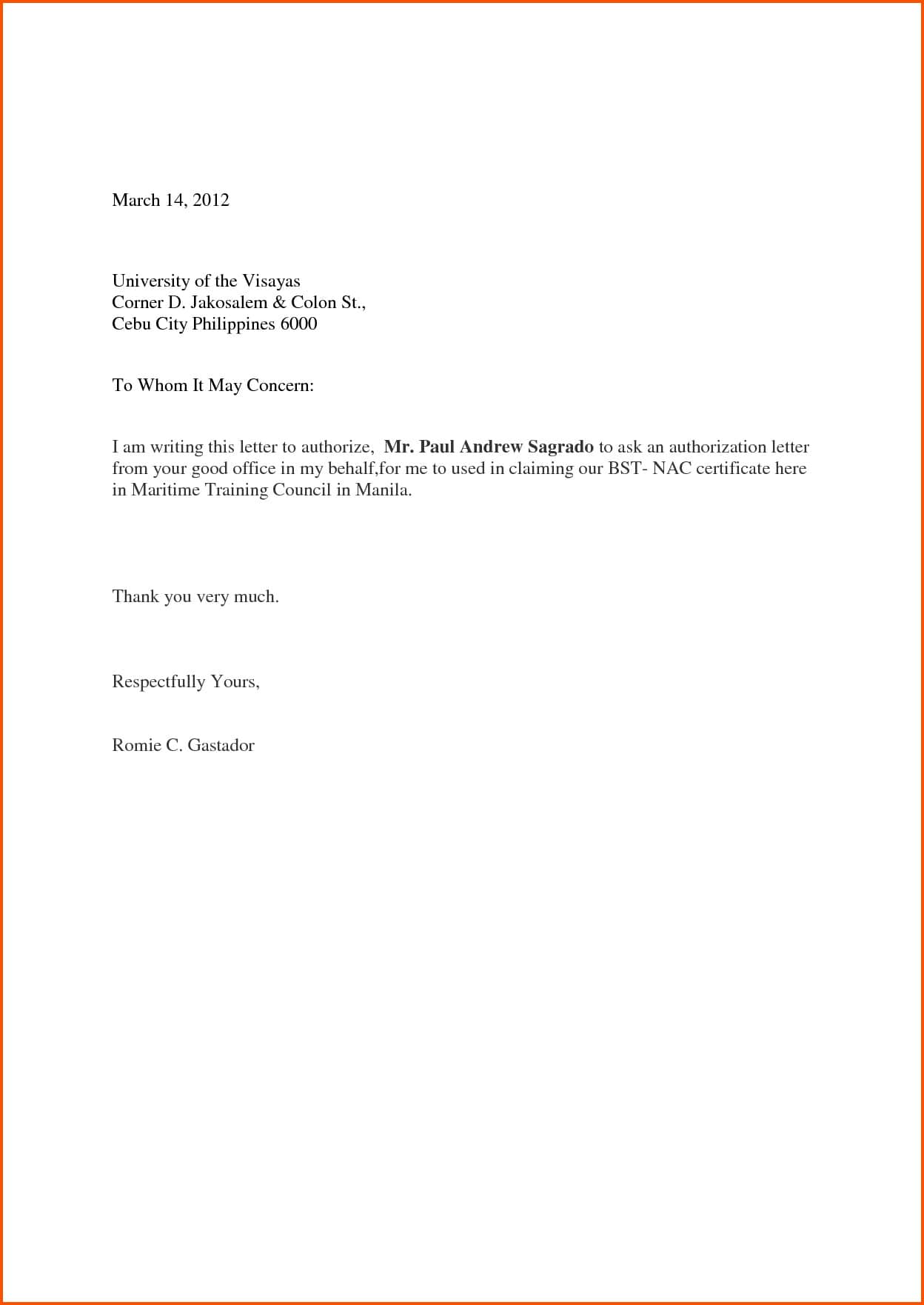
How to Write a Personal Authorization Letter
Unless you’re creating an informal authorization letter addressed to a friend or relative (is that even necessary?), you need to understand just how important it is to formulate a professional letter for business purposes.
Here are four easy steps to follow when writing a letter for authorization:
1. Address the recipient.
Any business letter starts with a formal heading. This includes the name and address of the recipient found at the upper left-hand corner of the page. It should contain their full address and their contact information to avoid any confusion. This must be followed by a greeting or salutation that properly addresses the recipient using the appropriate title and last name. If you don’t know the spelling or unsure about the recipient’s gender, then the greeting “To Whom it May Concern,” would be a safe bet. You may also see authorization letter format.
2. Provide a brief introduction.
When writing your introduction, cut to the chase. The first paragraph of your letter must clearly state who you are assigning the responsibility to by including the third party’s full name. You should also clarify the exact permission you are granting as well as you’re reason for doing so. It’s also best to indicate why the designated person has the authority to act on your behalf by stating your relationship with the subject. You may also see authorization letter for a child to travel.
Furthermore, explain why you need a representative in the first place. Your explanation may indicate that you are out of town, fallen ill, or working during the specified time. You need to be reasonable with your excuse for it to be accepted.
3. Create the main body.
This is the part where you’re required to expound what has been stated in the first paragraph of your letter. You need to mention all the responsibilities that are being granted to the representative in complete detail. Keep in mind that ambiguity may cause problems along the way. If you fail to mention what a person can and cannot do with the temporary power, especially when you’re being too broad about it, you may be permitting a person to perform critical actions without your knowledge. Restrictions are one of the most important things to point out in your letter. Spell out every detail in a brief and to the point manner to avoid misinterpretations. You may also see authorization letter to receive documents.
Ultimately, whatever they do will reflect and be treated as your own.
4. Close the letter.
In the last paragraph, cite the exact date or time period for which the proxy is permitted to perform the activities mentioned in the letter. You should also leave your contact information for recipients to stay in touch with you in case they have any questions or concerns that need to be addressed immediately. Do not forget to end the letter with a proper closing followed by your signature above your printed name. The document must be signed to prove that you are fully aware of what you are granting in the letter. You may also see letter of verification examples.
Tips for Writing an Authorization Letter
Now that we know the basic parts of an authorization letter, it’s time that we take a closer look at its content. While there may not be a hard-and-fast rule regarding the correct way to construct an authorization letter, there is a standard that must be met for it to deliver its purpose effectively. You may also see verification letters.
Let us take a look at a few guidelines to remember when writing an authorization letter:
1. Use an appropriate language
First and foremost, know your audience. Be careful about the language you are going to use; otherwise, you could be using an inappropriate tone. You should use a simple language that may be understood by the average person. Also, steer clear of any group-specific language that readers might not be familiar with. The idea is to make it easier for readers to understand the instructions being stated in the letter.
2. Write the full names of the parties involved
Write the complete name of the person you are granting the authority to. And because formality must be observed, avoid any endearments and other nicknames or shortcuts that people outside your inner circle may not understand. Apart from one’s full name, you should also mention an identity proof of the person, such as his or her Social Security number or employee code to avoid any sort of complications down the road. You may also see official letter examples.
3. Mention the date and time of the authorization
Specify the exact date and/or time for when the authorization is in effect. The beginning and ending dates must be stated and spelled out clearly to avoid confusion. But if you’re unsure about the exact dates at the moment, for instance, if you’re dealing with an emergency situation, you can provide an approximation instead. Rather than citing the specific time and date, you can indicate the number of days for when the proxy can act on your behalf. You may also see employee verification letter.
4. Clearly state how each task should be performed
In case you have certain preferences regarding how a task must be carried out, remember to mention it in your authorization letter. If you fail to do so, you can’t blame anyone for the aftermath other than yourself. For instance, if you’re writing an authorization letter for your secretary to act as a proxy in your absence, you need to specify what he or she can do. Is your secretary permitted to let people enter your office, sign vital documents, receive packages, or make critical business decisions during urgent situations? Ensure that you mention important details in your letter. You may also see salary verification letter.
5. Write in a professional manner
An authorization letter is similar to an ordinary business letter in more ways than one. This means that it’s always a good idea to follow the accepted standards for writing a business letter, where everything from the formal letter format to the content of the letter should meet a prescribed criteria.
6. Look for a witness or notary public if necessary
There are some authorization letters that play a critical function to the parties involved. If necessary, you’ll need to find someone who can observe while signing the letter. This person should be someone authorized by your local government or state to perform such action. Take note that this person may be a lawyer or someone who isn’t named in the letter. You may also see job application letter.
7. Proofread. Never forget to proofread your letter
If there are any spelling or grammar errors, especially in the names of the parties involved, the letter may be questioned and your request is likely to be denied by the agency or institution you submitted it to. Double-check for any mistakes and make sure that your letter is fully comprehensible even at first read. You may also see income verification letter.
Authorization letters are a written confirmation that permits a person to fulfill a set of actions on behalf of the letter’s writer. It is an important document used in a variety of domains, like medical, insurance, banking, personal, and business. You can use the letter to allow someone to obtain a copy of your personal documents and to disclose medical records in your absence. It could also be used to withdraw money from the bank, to make a business transaction, or to permit an underage child to travel without your supervision. For this reason, ensure that your letter contains all the essential information that the recipient must know about, and that it complies with the expected standards of a formal letter. You may also see promotion recommendation letter.
So if you find yourself in need of a personal authorization letter, be sure to keep these guidelines in mind.
FAQs
How do I write an authorization letter for someone?
To write an authorization letter for someone:
- Start with your name, address, and date at the top.
- Address it to the relevant party.
- Clearly state the name of the person you’re authorizing.
- Specify the tasks or decisions they’re authorized to make.
- Include the validity period.
- Close with your signature and name.
How do I write a self authorization letter?
Writing a self-authorization letter involves:
- Placing your contact details and date at the top.
- Addressing it to the concerned party.
- Stating your intent to authorize actions for yourself due to specific conditions.
- Detailing the permissions granted.
- Mentioning any identification details for verification.
- Signing off with your signature and printed name.
What is an example of a good authorization letter?
A good authorization letter example:
[Your Name]
[Address]
[Date]
[Recipient Name]
[Recipient Address]
Dear [Recipient Name],
I, [Your Name], hereby authorize [Authorized Person’s Name] to [specific actions they are permitted to carry out] on my behalf, starting from [Start Date] until [End Date]. This includes [specific details about the authorization].
Sincerely,
[Your Signature]
[Your Name]
How do I write a valid authorization letter?
To ensure your authorization letter is valid:
- Clearly identify yourself with contact information.
- Specify the authorized individual’s full name and any identification details.
- Clearly define the scope and limits of the authorization.
- State the letter’s validity period.
- Include a statement of voluntary authorization.
- Conclude with your signature and printed name, ideally in the presence of a witness or notary for added validity.
Is authorization letter legal?
Yes, an authorization letter is a legal document that grants another person the permission to act on your behalf in specific matters. Its legality depends on the adherence to relevant laws and the inclusion of necessary details such as the scope of authority, duration, and identification of the parties involved.


